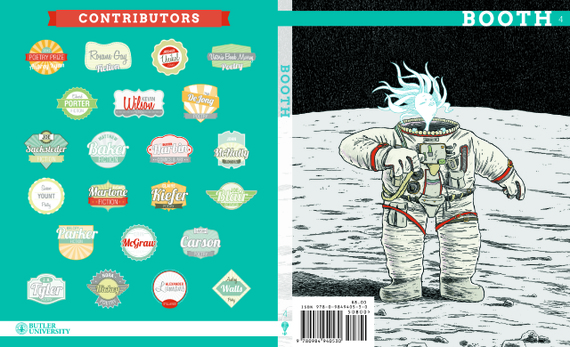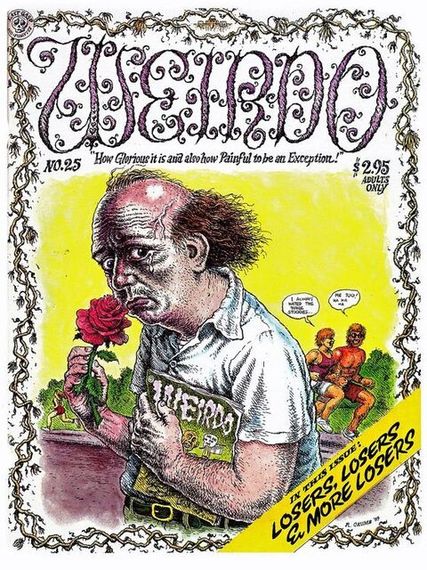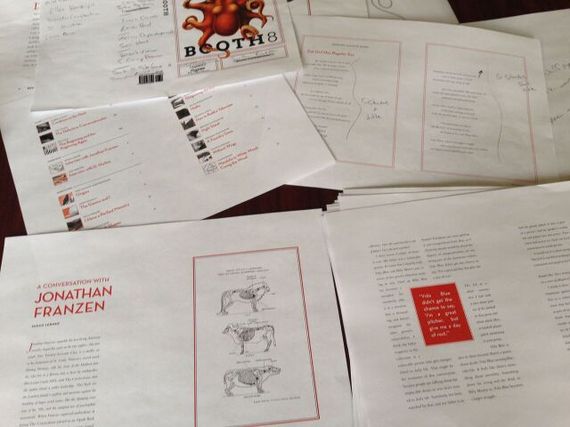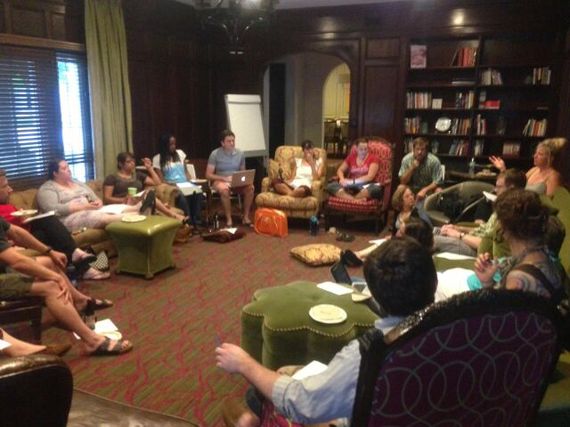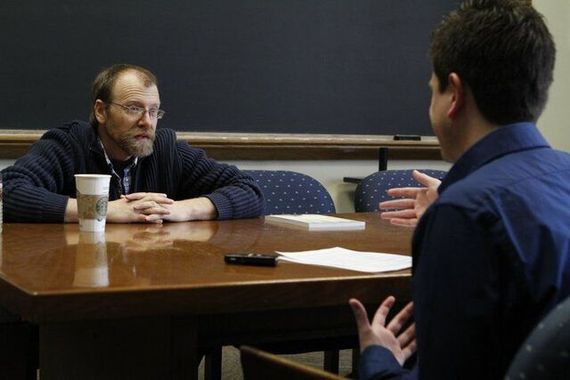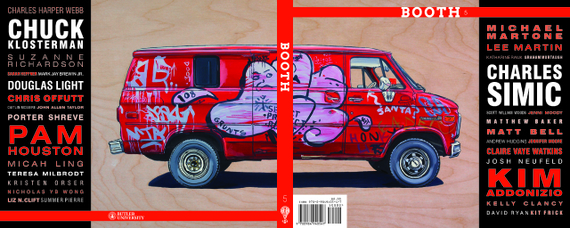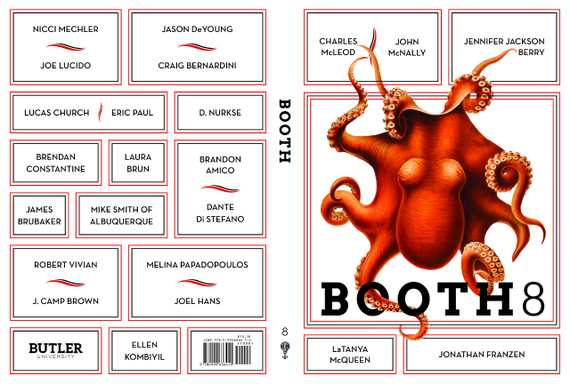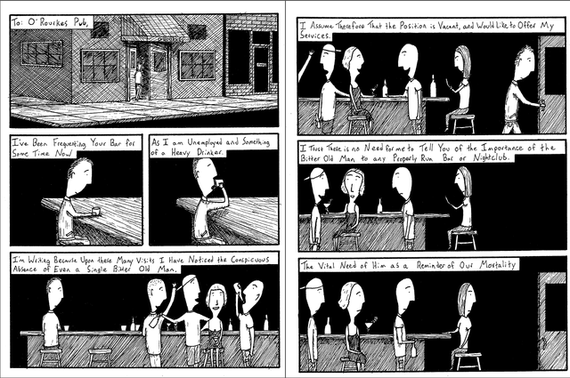I had the pleasure of meeting fellow Californian Robert Stapleton at a literary conference in Houston recently, and was struck by both the content and appearance of Booth: A Journal at the well-attended literary journal fair. My entire writing life has revolved around publication in literary journals, and in fact at the same conference I gave a presentation on how beginning writers can form rewarding, long-lasting relationships with sympathetic journal editors as a way to improve their writing over the long haul. Robert Stapleton was kind enough to answer my questions about his own interest in and commitment to the literary journal.
Shivani: When did you first think of starting a literary journal, and how did it come about? Is Booth your first experience in journal editing and publishing? How old is Booth, and how has it evolved?
Stapleton: When the English Department at Butler University [in Indianapolis, Indiana] created an MFA program in 2008, I was asked if I'd create a literary magazine for the students to work on. I don't believe they knew I had long harbored a love for lit mags. As a writer and reader, I've always been charmed by the possibility that voices and ideas could spring up from anywhere, geographies and stories I'd never imagined, maps on a more intimate scale than big publishing sometimes allows.
When my wife and I used to drive across the country in our twenties looking for funky college towns and bookstores to hang out in, I naturally gravitated to local literary scenes and publications as a way to understand the unknown. For instance, in the nineties I fell in love with Kinesis, a literary zine out of Kalispell, Montana. It was 8½ x 11 and published on newsprint, nothing fancy, but I got an incredible rush every time a new issue arrived in my mailbox. Kinesis combined short fiction and poetry with essays about fishing, wine-drinking, and natural living. I was hungry to understand how people lived elsewhere, and with each issue I felt more connected to the wildness of Montana and the stories they told each other.
When I was a little younger and spent more time alone, I was saved for a bit by discovering Robert Crumb's comics' anthology magazine Weirdo at Blue Wolf Books in Fullerton, California. These were comics by and about people who didn't fit in--and didn't know how to fit in. I bought every issue I could find and felt okay for a bit. Also, I was floored to learn that there were magazines and a publishing world for stories about people on the margins of society. I still have my collections of Weirdo and Kinesis and could not imagine letting them go.
I've always enjoyed making books. As an MFA student at Long Beach State, this meant serving as editor of Riprap. When I taught high school, this meant serving as yearbook advisor and also creating a schoolwide literary magazine for student editors and writers. And now as a college professor, I get a modest budget for a magazine--and total freedom to develop a vision with our student editors.
Shivani: In the crowded landscape of print and online literary journals, what makes Booth stand out?
Stapleton: I might not be the best person to answer this. I'd like to say that our print vehicles are unique in their embrace of design and designers, in their love of timeless narrative instinct--while simultaneously championing postmodern sensibilities such as inventive forms, lists, comics, and other miscellaneous ways that words can become literature, but then I immediately think of terrific magazines like Passages North, Gulf Coast, Salt Hill, or Ninth Letter. They are all doing beautiful and immediate work, too.
Shivani: What is your focus in arranging the content for each issue, and have your interests and emphases changed over time?
Stapleton: I take printouts of everything that will appear in an issue and lay them out on a conference table in the Publishing Lab at Butler. Then, much like a record producer considers the arrangement of songs on an album as an emotional journey, I consider a front-to-back reading experience, even though that is not likely how readers consume a literary journal. For instance, I won't put too many sad/death pieces in a row. I try to pepper humor and irreverence throughout. I usually like to start with something short and sexy. Booth 9 ends with a short poem as prayer, M. Shahid Alam's "In Memoriam." I like that as a bookend.
Shivani: How is a journal like Booth, edited by a faculty member, different than journals run by MFA students?
Stapleton: We have around 25 MFA students who work with me on Booth. They serve as readers, publishing interns, and section editors. They read 99% of the submissions that come in and push the best up the ladder. Once we month we gather over food and drinks at our MFA house and debate what to publish. These infrastructures are all fairly consistent across many other university journals. I am, perhaps, more involved with design and the physical product than traditional, hands-off advisors, but we are a fairly new program and literary brand and are working to develop a richer identity. Butler's Vivian S. Delbrook Visiting Writers Series is already one of the best in the nation, and we consider Booth to be on the same trajectory, though it might take a little extra sweat in the early going.
Shivani: What recent fiction, poetry, or interviews in Booth are you most proud of? Is the job of a journal editor fulfilling?
Stapleton: As an editor, I get to celebrate and share work that I've fallen in love with. This is a profound privilege. Also, I get to make this work appear on the page as beautiful as possible. I care everything about whether our writers and artists feel like they have found a good home for their work. If they're happy, we consider our job to be done--and done well. So, on the one hand, it is neither satisfying nor fun to reject over 99% of the submissions that come in. But it is highly satisfying to get to shout from the rooftops about the 1% that we love and get to deliver to a wider readership.
As for work in Booth that I am most proud of, there are so many that mean so much to me and our staff, but probably nothing more, for me personally, than the Nick St. John comic, "How I Came to Work at the Wendy's" (Booth 6). When we debate what to publish, my staff uses the word Booth as an adjective, as in, "Is it Boothy?" I tend to resist this notion, because the minute we have an expected behavior or type of material, I'm more interested in the opposite, the unexpected. For me, though, if anything is "Boothy," it's this incredibly inventive tale of lost love and a character looking for a purpose. It both infuses your heart with hope while also lighting a cherry bomb to it.

Shivani: I notice that you pay special attention to design, in every sense of the word. Booth is a truly beautiful production. Why this emphasis? How long have you been interested in production values, and how is design affected by new technologies? You can get as geeky here as you wish!
Stapleton: I wish I had more geek for this answer. Or at least a reason. I have no artistic or design background. My parents and their parents were laborers. There is no artisanal blood in my family whatsoever. As a kid, I read a lot of Mad Magazine. And my brother and I paid great attention every year to the newest baseball card designs when they were released. We collected throughout the 1970s and 1980s, and in 1981 the industry went from only Topps cards to Topps and Donruss and Fleer. Now we had three card designs to collect and compare every year! A little later I fell in love with comics through Crumb's Weirdo--and this led me to the work of Harvey Pekar and Peter Bagge and the Hernandez brothers and so many more.
OK, here's a little geek: I love and collect books that offer unconventional maps as stories. I am certain there are meaningful ways to visualize stories and plot arcs, and I love to think about how maps can tell us so much more than a location. I often ask my creative writing students to map out their childhood homes, neighborhoods, bedrooms, schools, etc. We don't just come from people; we also come from places and landscapes. And with visual topographies, we can tap into some of these moments when locations serve as our ancestors.
Here's a little more geek: On my computer my Bookmarks menu is filled with art and artists that I'd love to publish. It's not hard to find design work you appreciate if you keep looking. And I can no longer keep up with how many artists are linked on my menu bar. I open it and keep scrolling down and name after name appears, and I no longer remember what artist name is doing what kind of work. I tend to feel like this is a failure of organization and is more evidence that I am a fraud as an editor. Isn't this what so many of us secretly feel like from day to day: that someone is about to discover what a fraud we are? But at Writefest in Houston recently, I was talking with Kayla AE, the editor of Nat. Brut, a complexly beautiful lit mag. And she said that she has the same problem with her Bookmarks menu! It was so great to hear another editor say they struggle in the same way. Either we're both doing solid work, or we're both frauds!
Shivani: What do you see as the future for Booth?
Stapleton: Our next print issue will be our tenth. I'd like to do something bigger for this anniversary issue. And while I'm not inclined to give much away yet, I will say that this part is my favorite, the dreaming and conceiving and wondering if a visual idea will work, the possibility of beauty at every new turn, and then the sitting down with our designer and pitching and fussing over every new font and kerning and spotting the widows and orphans and imaging the relationship in the table of contents and then determining how the page footers will look and the movement from title to byline. And that's before we get to the art and comics and the stuff that naturally looks pretty. Even after all that, we still get to decide what the paper weight will be, and whether or not to offer an interior cover and do we do full bleeds or not for the art, and if we do, do we arrange on the right or left of a spread? These may sound like minor details, but as we are responsible for how someone's deep, deep work gets presented to the world, this is very sacred and profound stuff.
Beyond our next issue, Booth 10, we will continue to champion work that delivers on three levels: concept, execution, and gravity. We will look for work that offers the right surprise. We will look for inventive forms and miscellany as literature and we will look to shimmy left when we're expected to shimmy right. We will defamiliarize the literary journal while sharing with our readers how sweet it is to fall in love with literature all over again.
